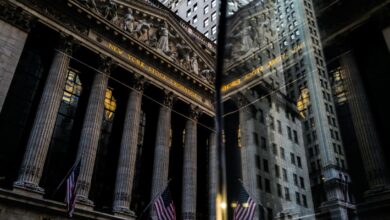More capital is not the answer

Good morning. Two-year Treasury yields (known by law in the financial press as “rate-sensitive two-year yields”) are almost back to where they were before Wednesday’s benign inflation data. One good consumer price index report is not enough to cure the inflation scaries, it seems. Email me if you think the market is too timid: robert.armstrong@ft.com.
Friday interview: Steven Kelly
Steven Kelly is the associate director of research at the Yale Program on Financial Stability, where he works on the prevention and fighting of financial crises. He has for some time been Unhedged’s go-to source whenever the financial system starts to show signs of stress. We sat down with him to discuss capital requirements, liquidity, stablecoins, money market funds and much else.
Unhedged: Let me start by asking you to respond to JPMorgan’s Jamie Dimon. He has made three complaints about the Basel III banking standards. One: there is enough capital in the US banking system already. It has been tripled to $900bn since the financial crisis. Two: if you do make banks add more capital, they will lend less. Certain forms of credit will leave the banking system. We’ve already lost leveraged lending; your grandmother’s mortgage is next. Finally, when this activity leaves banks, it will go to dark and unregulated corners of the financial system where you don’t want it.
Steven Kelly: He’s right, at least in some sense, on all three. He says there is no evidence of undercapitalisation system-wide. That’s true. It’s probably important to remember that, even in the pre-global financial crisis system, where you had banks pushing 30 to 1 leverage, there was enough capital most of the time. It very much wasn’t enough capital for the 2008 scenario, but prior to that, it was enough.
Unhedged: “Most of the time” is not the problem in banking, though.
Kelly: Right. But with that as a starting point, Dimon is right that we tripled banks’ capital ratios post-crisis. And so now the fight over whether capital ratios should be 12 per cent or 15 per cent is not going to make a difference. It’s not going to make a substantial difference in the risk of financial crises. We’re not going to get the same benefit that we saw from what we did post 2008.
The most appropriate probability of a financial crisis is not zero. If you set up a system with 0 per cent chance of a financial crisis, you have wrecked your economy. You’re trying to dial into the appropriate risk of financial crisis versus cost to the economy and the banking system, and you want the incentives to be correct. To the extent Basel III endgame is about trying to get rid of quarterly window dressing on bank balance sheets, I think that’s an unequivocal good. Or if it says, we don’t want you to be able to manipulate your own models and have that output serve as your capital requirement, that’s an unequivocal good.
The question is, “Is the proposed capital level appropriate or not?” But what is more important than the level is the flexibility.
Unhedged: What do you mean by flexibility?
Kelly: If we have Treasury market volatility we’re talking about, how is the Fed’s going to intervene? When commodities blow up in Europe, we’re saying, is the ECB going to intervene? We have healthy banks, and we’re still talking about central bank intervention in all these various markets. The UK is literally setting up a facility to intervene in the non-bank financial market. That is a testament to the lack of flexibility [of capital requirements]. Jamie Dimon makes this point all the time: look, we would love to intervene and right these markets, and we see obvious arbitrage opportunities, but we have limited flexibility in our capital requirements to step in. And there’s a reason for that. Think of 2007. Banks used their flexibility and brought a whole bunch of stuff on a balance sheet. They tried to call the bottom and then 2008 happened, and it was an absolute nightmare that they had all this garbage on their balance sheets. So there’s the central limit to, “we trust the banks to call the bottom”. But now we’re in the other situation, where regulatory capital ratios are not flexible enough to let banks intervene when they should.
Unhedged: So, we need banks to intervene in financial markets when disruption has created profitmaking opportunities, and the current capital rules foreclose that possibility.
Kelly: Correct. It is not just, “oh, we should let banks profit”. Those opportunities are real financing opportunities in an economic disruption. When commodities markets dealers and producers are in trouble, we want banks to be stepping in and smoothing markets.
Unhedged: What would a regime with adequate capital requirements that allowed for greater flexibility look like?
Kelly: This is what’s really hard. It has to be a greater discussion with supervisors over risk. There are some areas of regulation where we do this, where banks have to show their work to supervisors: “Here’s why we made these assumptions in our internal stress test,” or whatever else. And the supervisor says, that makes sense to us, or not. To some extent we need that with capital requirements. The problem with setting a hard ratio is the banks are going to hit it exactly. You can lower it, you can increase it, but you end up in the same position. Say you lower capital requirements by 10 per cent. Banks are just going to run on lower capital, and they still don’t have the flexibility to intervene.
Unhedged: So I’m large bank X. I’m maintaining my required capital ratio. And something goes on in the commodities market. I want to get in there. I say to my supervisor, I’m at my capital ratio, but there’s an opportunity. Let me extend some capital into this market and stabilise things, and here’s why I think that’s safe to do on a temporary basis.
Kelly: And you say why it would actually be accretive to capital. This is how this debate gets framed. People will say “Capital isn’t something you hold. It isn’t the cash in a lockbox. It’s just a different way to finance your balance sheet.” And that’s true. But raising equity is complicated. You have to go do an equity raise. You can create deposits at a keystroke when you make a loan. If you want banks to be flexible, they have to be able to lever up in short order through creation of deposits or going to the repo market. Those things can happen overnight, and they can stabilise markets. Otherwise you’re in a world where the banks go, “Well, we’re at our capital constraint, so where are you, central banks?”
Unhedged: I guess the worry is you create a system where you have the slick banker against the slightly clay-footed regulator and the regulator gets outfoxed.
Kelly: Totally. This is absolutely the challenge with modern supervision. This is how supervision used to be. There was a debate and a discussion. There has to be due process here to some degree; you can’t just have some entry-level supervisor telling Jamie Dimon how to run his bank. But the reality is we do that, within boundaries, with some regulations already, and there is scope for that in capital regulations as well.
Unhedged: OK, next point: the idea that banks will lend less if you increase these capital requirements.
Kelly: True. It’s totally mechanical. You cannot say to a bank, “OK, what you used to be doing with par value deposits you now have to do with equity,” and expect the same amount of output on the asset side. One is just demonstrably more expensive than the other. There is no Modigliani-Miller idea that, all else equal, you have a less levered bank therefore its cost of capital should be the same. No, because deposits offer all these kinds of services. They are our money. They are our most fundamental demand. That’s the starting point for banks. Banks start with, how do you create a deposit franchise, and only after that, what do I want on the asset side.
Unhedged: OK, third issue. We are pushing these well-regulated banking activities into an unregulated nether realm of private credit and that is scary. Agree?
Kelly: To some degree. Obviously, all business activity everywhere has to be regulated for fraud. That’s step one. But should bank regulators regulate all fraud in the world? No. The banks have systemic importance because of their liability structure. And so to the extent you can push credit risk and risk of losses on to a more stable capital structure, and you’re letting the market do that for you as opposed to by regulation, I think you can accept that there’s a limited economic cost to that. There is risk, potentially, on the asset side to the extent that it’s less supervised. But not a risk of loss for deposits.
The other thing is that there’s limits. You cannot simply reinvent a system that’s levered 15 to 1 in a 1 to 1 leveraged system. You can’t just take everything in the banking system and put it over private credit because people need deposits. Again, the starting point for banking is, what can I put on the asset side of the balance sheet that helps to manage a deposit franchise that gives me super-cheap funding. So it makes sense for banks who want to shed certain risks to something like private credit.
Unhedged: It sounds like, whereas you’re sympathetic to Dimon on the first two points, you’re less sympathetic on the third because, you know, banking is not going to disappear. Deposit franchises will continue to exist. There is just a rebalancing between these two ways of funding credit.
Kelly: Right. For example, Bank of Montreal sold a bunch of recreational vehicle loans to KKR private credit. And how does KKR finance it? With a loan from Bank of Montreal. So Bank of Montreal’s balance sheet is essentially unchanged in size. But the capital risk is much lower. They now have a senior loan to KKR or KKR’s fund, as opposed to having this portfolio of RV loans that, now that interest rates are really high, is going to have a bunch of credit workouts and all this stuff banks are not actually any good at.
Unhedged: What did we learn from last year’s bank blow-ups — Silicon Valley, First Republic, and the others?
Kelly: The capital issue with the banks that failed is that they did not have enough capital for their business model. Think about the interest rate risk of Silicon Valley Bank. So much has been made of their portfolio of long-term assets that went down in value when rates rose. And that’s all correct. But there were a few dozen banks that were similarly situated that did not fail and did not experience runs. Part of the story is the interest rate sensitivity of SVB’s liabilities. When they came out in March [2023] and said our clients are running down cash balances much faster than we expected, that turned those unrealised losses in the long-term assets into realised losses, because the assets needed to be liquefied.
That’s why you can have a Bank of America with $100bn of unrealised losses and nobody is worried, because the business model of Bank of America is strong. If BofA needs capital, they can get it in two seconds, and there is no interest rate sensitivity in their deposits. SVB was dependent on equity flows from venture capital into technology for their deposits. Its funding was macroeconomically sensitive in a way that its supervisors did not recognise. SVB thought they had the most loyal depositors in the world. Maybe they did, but if you need your money, you need your money. So when money stopped flowing into tech, which is an interest rate sensitive sector, the liability story for SVB just exploded.
Unhedged: Did we learn lessons about the rules governing what can be accounted for as “available for sale” and what is classified as “held to maturity” — that is, what has to be marked to market and what does not?
Kelly: In a crisis, the system always looks bad. Once you’re in a run, it’s like, why the hell did we ever let the banks value things at not what they are worth? We definitely learned that fair value marks anything that’s available-for-sale should not be exempt from capital requirements. Part of Basel III endgame is getting rid of that. Weeks before SVB goes down, you have their CEO in the Financial Times saying, hey, we’re fine because we can repo [borrow against] our held-to-maturity securities if we need to. But you only get the market value when you repo something. If you are in the FT saying you can repo something, that thing cannot be held to maturity for accounting purposes.
But the other thing is, if you think about what a mark-to-market loss is, it’s marking the asset to the Treasury curve. So if Treasuries go to 5 per cent, you mark the asset at 5 per cent. But if you’re JPMorgan, you’re paying 0 per cent on your deposits. People say, why don’t you just mark everything to market? Well, that’s not really representative of JPMorgan’s funding curve. It became representative of Silicon Valley’s funding curve because they had to sell everything. JPMorgan is never going to pay 5 per cent for funding. So mark-to-market accounting is kind of appropriate for them. If anything, you could be booking at a premium if you’re paying 0 per cent for deposits. Again, it goes back to how economically sensitive your deposit franchise is.
Unhedged: But it’s hard to set accounting rules about what is mark-to-market and what it’s not based on an analysis of the economic sensitivity of a business model — that’s not a number. It’s a judgment.
Kelly: The accounting rules should stay, but the bank is the one doing the classification. And so the bank and the supervisors need to be thinking about how realistic the classification is.
Unhedged: We’ve talked about the standard complaints about the regulatory regime. But, let me ask you positively what needs to happen to improve stability. What will be done when you’re in charge?
Kelly: We should regulate things that actually look like banks as banks. So as a starting place, stablecoins should be brought in under the banking net. Similarly, we could probably do more on money market funds.
With stablecoins, if you think about what they’re doing, they’re harvesting what could be insured deposits and placing them, as uninsured deposits, back into the system. We saw this starkly with [stablecoin operator] Circle’s $3.3bn deposit in SVB. That became an uninsured deposit which had a fiduciary responsibility to run. They argue, hey, we don’t lend out reserves, but they absolutely do. It’s a bank. They take money from customers and they lend it out in the form of uninsured deposits.
Money market funds I’m more sympathetic to just because there’s a clear demand story, from the real economy. If you’re a company and you have more than $250,000 in cash, you want some form of protection that isn’t just uninsured exposure to your bank. And so part of it is we have to reform deposit insurance, and make the limit higher. We can index it to inflation. We can protect all business accounts. There are various proposals out there. But the direction of travel should be substantially higher, if for no other reason than we know uninsured deposits rarely actually are what they’re called, because it’s such a systemic risk to bail in uninsured depositors.
One good read
On the future of Paramount.
FT Unhedged podcast

Can’t get enough of Unhedged? Listen to our new podcast, for a 15-minute dive into the latest markets news and financial headlines, twice a week. Catch up on past editions of the newsletter here.





